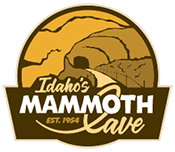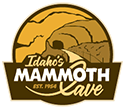Idaho’s Snake River Canyon offers some of the state’s most dramatic scenery, filled with towering rock walls, quiet coves, and thundering waterfalls. While many visitors flock to Shoshone Falls, another captivating spot deserves attention: Pillar Falls. Named for the tall rhyolite pillars that split the Snake River into multiple channels, Pillar Falls is a hidden gem for kayakers, hikers, and geology buffs seeking something beyond the usual overlooks. Below, we’ll explore how to reach Pillar Falls, what makes it unique, and why safety should always come first when visiting.
A Hidden Gem in the Snake River Canyon
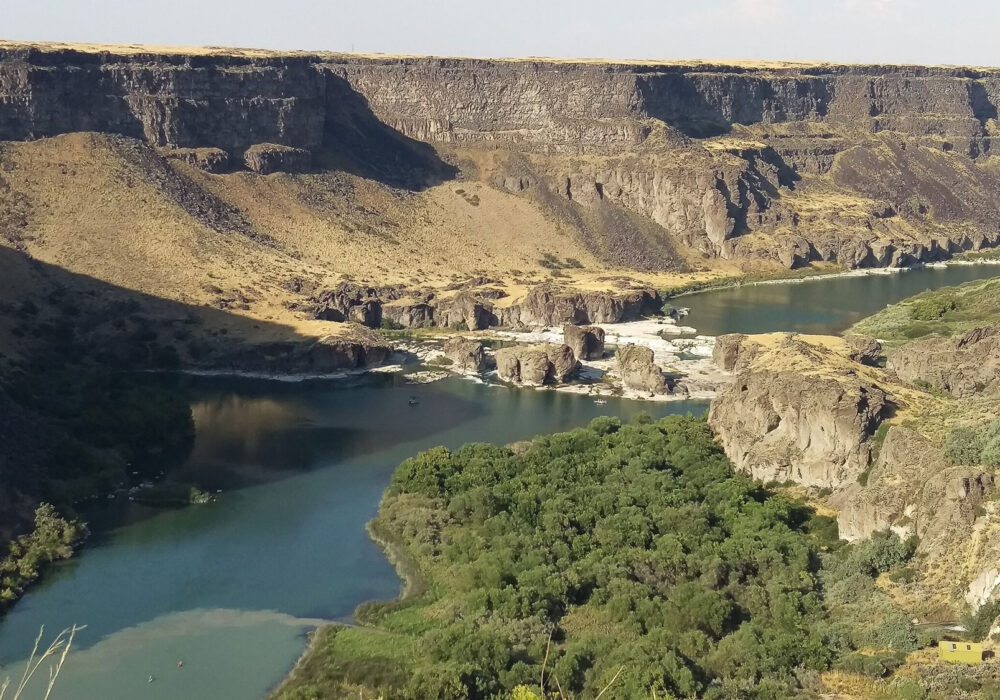
“Pillar Falls Snake River Canyon Twin Falls Idaho” by Evan K. Bastow is licensed under CC BY-SA 4.0.
Pillar Falls sits about one mile east of Idaho’s well-known I.B. Perrine Bridge in Twin Falls. Here, the Snake River breaks into a network of smaller drops and rocky corridors before flowing downstream. When water levels are lower, sections of exposed stone create a maze of channels that can be walked upon—offering a close-up look at rhyolite formations and gentle cascades. However, rising river flows can easily submerge these pathways, turning what seems like a calm area into powerful currents beneath the surface.
Despite the peaceful appearance of certain pools, Pillar Falls is not a safe place to swim. Strong undercurrents can lurk below, even when the surface seems flat. The best way to appreciate Pillar Falls is to arrive by kayak or other small watercraft, wearing a life jacket, and carefully explore when river conditions allow.
The Geology Behind Pillar Falls
The Snake River Canyon formed through a mix of volcanic activity and large-scale flooding events. Basalt and rhyolite deposits make up much of the canyon’s rock, each with distinct colors and textures. Rhyolite, typically lighter and sometimes pinkish, is more resilient in places, leaving pillars standing when the surrounding material erodes away. Over thousands of years, water has sculpted these pillars into the shapes you see today.
Pillar Falls sits near an area shaped by the ancient Bonneville Flood, which carved the canyon’s path roughly 14,500 years ago. This monumental flood scoured out the Snake River’s course, exposing layers of stone and creating pockets where columns and rock towers now stand.
Kayaking to Pillar Falls
Getting Started
Most people who want a closer look at Pillar Falls begin at Centennial Waterfront Park, roughly two miles downstream. Paddling upstream can be tiring, so plan your timing well—mornings and early evenings often have calmer winds, making the trip a bit easier.
Passing Under the Perrine Bridge
Your journey will take you beneath the Perrine Bridge, a famous spot for BASE jumping. Looking up, you might see people leaping from the bridge while you skim across the calm waters below. The canyon walls loom on either side, sometimes dotted with vegetation or small seeps of water that dribble down into the river.
Arriving at Pillar Falls
As you round the bend, you’ll notice the river’s flow changing, and towering rhyolite pillars rising from the water. The sound of rushing water intensifies where small rapids form between these columns. Depending on water levels, you might see a series of mini-cascades or just subtle ripples. Many paddlers land on the south side to carefully exit their kayaks. Even in lower flow, the surface can be slippery, so wear stable footwear.
Exploring on Foot
If the water is low enough, you can walk among the pillars. Pools of varying sizes form around the rocky corridors, and some pillars stretch high overhead, giving the area a surreal look. Remain watchful for changing currents, and note that no matter how calm it looks, you should not swim here. Undercurrents make the pools deceptively dangerous. If you’re continuing upriver to Shoshone Falls—an extra two miles—prepare to portage your kayak across the rocky terrain.
History & Local Lore
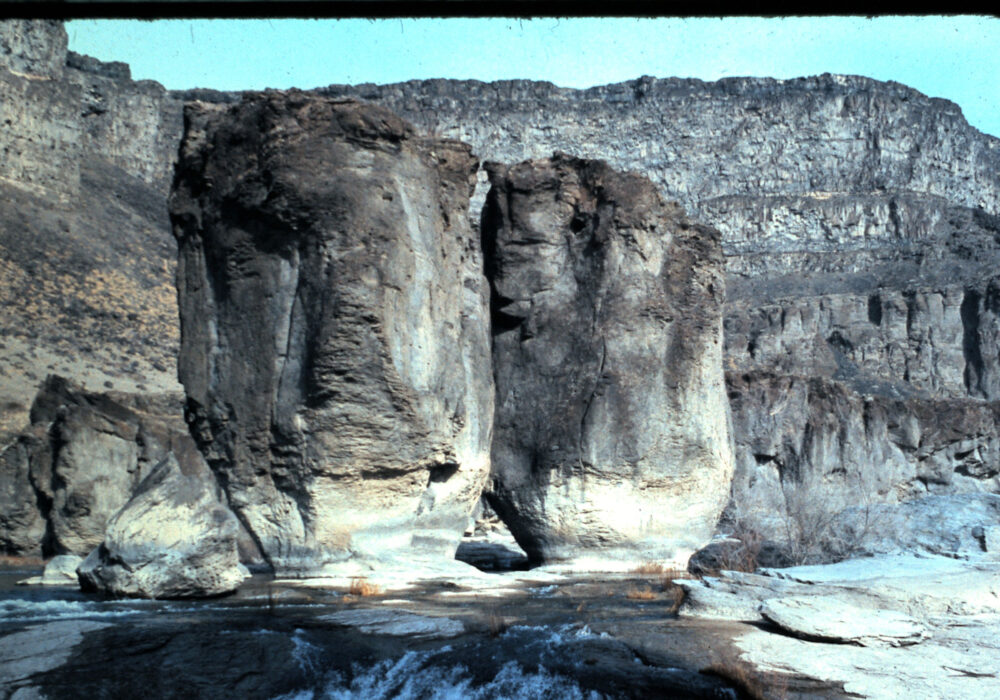
“Pillars at Pillar Falls – Snake River Canyon, Twin Falls, Idaho” by Evan K. Bastow is licensed under CC BY-SA 3.0.
Engineer R.M. Murray, who worked on the Hansen Bridge in 1919, once proposed building a massive suspension bridge between Shoshone Falls and Pillar Falls. This bridge would have been among the longest in the United States at that time, measuring around 1,143 feet. Murray hoped to finance it through tolls and draw visitors with its scenic views. However, the plan never materialized, leaving Pillar Falls to remain in its natural state.
The Snake River has long been significant to local tribes and early settlers alike. Though some saw Pillar Falls as an obstacle for navigation, others viewed it as a striking landmark along the canyon’s path. Today, the falls remain a lesser-known spot mostly visited by local adventurers, kayakers, and geology enthusiasts.
Things to Know Before You Go
- Check Water Levels: The Snake River’s flow can vary daily based on dam releases and seasonal runoff. At high flows, Pillar Falls may be completely submerged, making walking around impossible. Low or moderate flows usually offer the best chance to explore.
- Safety Above All: Swimming is never recommended at Pillar Falls due to strong and unpredictable undercurrents. It is essential for anyone in a kayak or small watercraft to wear a life jacket at all times. If you must carry kayaks over wet rocks, proceed slowly, remain cautious of your footing, and be mindful of slippery surfaces.
- Access Points: You can start at Centennial Waterfront Park, located roughly two miles downstream as a primary launch site for kayaks, or view Pillar Falls from the Snake River Canyon Rim, which offers only a distant perspective from above without a clear look at the falls themselves.
- Gear & Clothing: Quick-dry clothing, sturdy sandals, sunscreen, and a hat are all good choices. Avoid flip-flops that might slip off in the water, and bring a waterproof bag for phones or cameras.
- Time & Effort: You may need over an hour to paddle upstream for two miles, depending on your fitness level and the river’s flow. If you choose to walk around Pillar Falls, take a relaxed approach, but keep track of the time, especially if you intend to reach Shoshone Falls or return before nightfall.
Best Time to Visit
Late spring through early fall is generally the best window. By midsummer, flows are often moderate, making it easier to walk around the exposed rock near Pillar Falls. Summer also means warmer air and water, although the current remains strong in places. Fall can be a quieter season, but days shorten, and mornings or evenings can be cool. Always verify water conditions regardless of the season; a sudden release from an upstream dam can alter the river overnight.
Wildlife & Scenery
While paddling, you might spot sturgeon rolling on the surface, herons fishing along the shore, or ospreys diving for food. The canyon’s basalt walls sometimes host swallows that nest in small cavities. In calmer backwaters, you may see smaller fish darting around. Pillar Falls itself draws attention to rhyolite formations—lighter-colored than the typical basalt. These stark columns create a strong visual contrast, especially under the bright summer sun.
On foot, you can see how water has carved smooth channels and pockets around the pillars. The shapes might look random, but they reflect thousands of years of erosion. If you enjoy geology, Pillar Falls can become a real-life lesson in how volcanic rock weathers in a swift-moving river.
Nearby Activities
- Canyon Rim Trail: For those who prefer strolling along the top, the Snake River Canyon Rim Trail features viewpoints of Perrine Bridge, stretches of the Snake River, and glimpses of Pillar Falls from afar.
- BASE Jumping at Perrine Bridge: While not part of the falls, watching BASE jumpers is entertaining. You’ll see them drift down to the canyon floor, sometimes landing near the same waters you just paddled on.
- Downtown Twin Falls: After a day on the river, you can head into town for local dining options, coffee shops, or to stock up on gear for your next outing.
Practical Tips
- Local Rentals: If you don’t have a kayak, consider renting from one of the local outfitters. They often provide life jackets and can share up-to-date river flow details.
- Respect Private Land: Some canyon areas have private ownership, so stick to established put-ins and take-outs. Centennial Waterfront Park is a public space but be mindful of posted regulations.
- Bring Supplies: Pack at least one liter of water per person, snacks, and sun protection. The canyon can heat up quickly, and reflection off the water can intensify sunlight.
- Cell Service: Reception might be spotty in parts of the canyon. Let someone know your plans and expected return time.
Why Pillar Falls is a Beautiful Place to Visit in Idaho
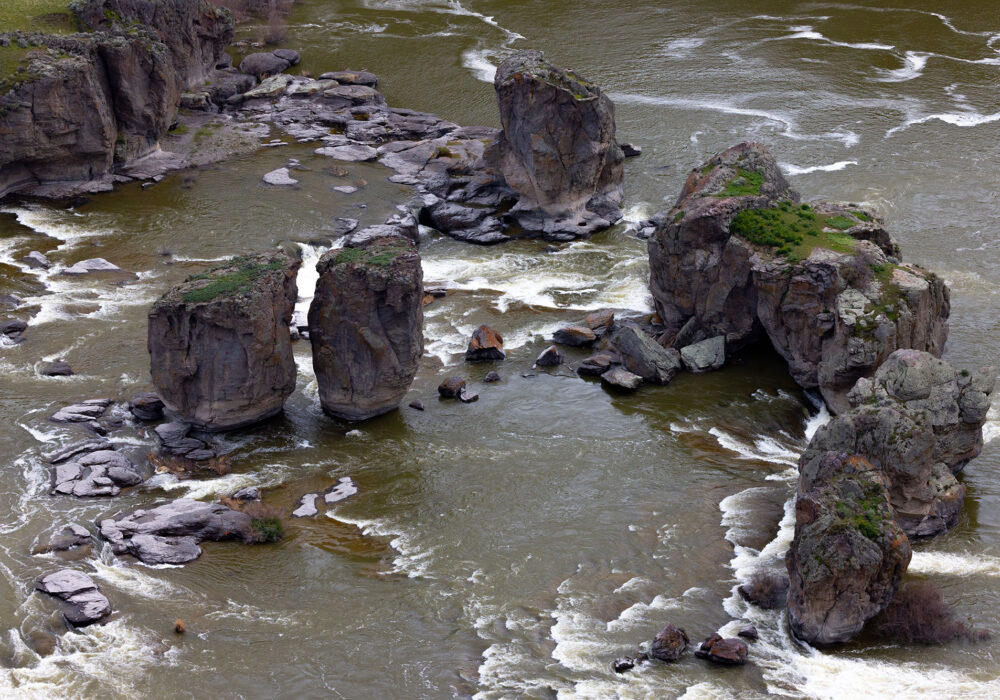
Pillar Falls is a lesser-known part of Idaho’s scenic Snake River Canyon, offering a special glimpse of how water and volcanic rock can shape a landscape into something both beautiful and dangerous. The tall rhyolite columns, multiple mini-falls, and hidden pools make for a memorable outing—particularly if you enjoy kayaking or discovering geological features up close. Still, the area demands caution and respect. No matter how tempting it looks, the swirling undercurrents mean you should never swim here. And if you venture onto the rocks, make sure water levels are low enough to keep you safe.
By approaching Pillar Falls with the right gear, the right mindset, and an appreciation for the Snake River’s power, you can experience a beautiful place to visit in Idaho—one marked by surreal stone formations, gentle cascades, and the calming sound of water echoing through the canyon. It’s an adventure that captures Idaho’s wild spirit, rewarding those who take the time to see what the Snake River Canyon truly has to offer.
Quick Facts About Pillar Falls
- Pillar Falls is located about one mile east of the I.B. Perrine Bridge in Twin Falls, Idaho.
- Tall rhyolite pillars give the falls their name and divide the Snake River into several small drops.
- The only reliable way to see the falls up close is by kayak or small boat, usually launching from Centennial Waterfront Park.
- Even in calm-looking pools, swimming is never recommended due to strong undercurrents.
- Water levels on the Snake River can fluctuate rapidly, so check local conditions before setting out.
- During lower flows in summer, more rock formations emerge, allowing careful exploration on foot.
- Kayakers sometimes portage at Pillar Falls on their way to Shoshone Falls, which lies another two miles upstream.
- In 1919, an engineer proposed building a massive suspension bridge here, but the project never materialized.
- Unlike the single drop at Shoshone Falls, Pillar Falls is made up of multiple mini-cascades and channels.
- Visitors can view it distantly from the canyon rim, but the best experience is on the water—with safety gear at all times.
Idaho’s Mammoth Cave
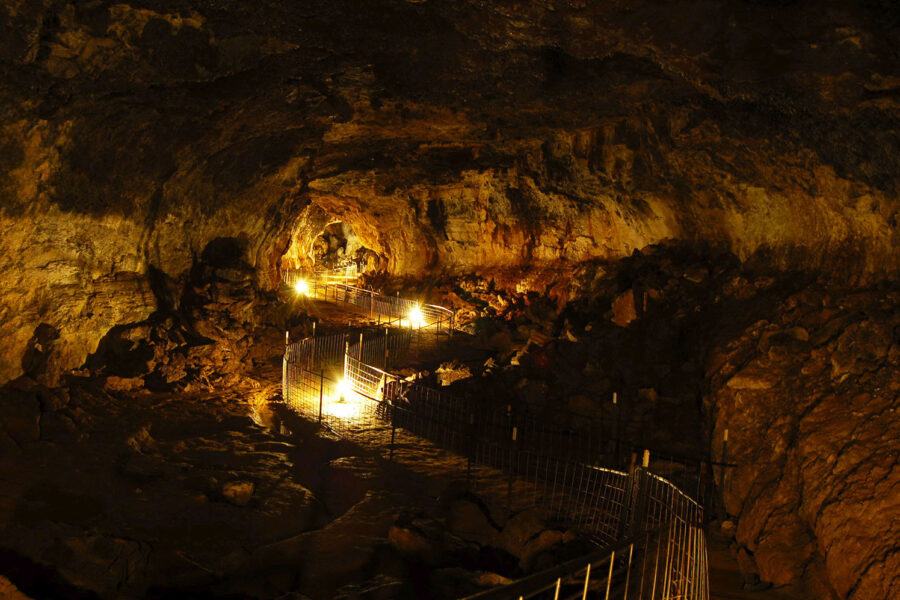
Planning a trip to Idaho? Don’t forget to put Idaho’s Mammoth Cave at the top of your list. As one of the most beautiful places to visit in Idaho, you can explore a unique and awe-inspiring underground landscape at your own personal pace with our self-guided tours. In addition to the cave, there are two privately owned museums of natural history on-site, the Shoshone Bird Museum and the Richard Arthur Olsen Museum featuring a wealth of exhibits that has earned them nickname “The Smithsonian of the Desert,” making it an unforgettable stop for the whole family.
Located eight miles north of Shoshone, Idaho, on Highway 75, Idaho’s Mammoth Cave will be open for seasonal tours from May – October, from 10 a.m. to 6 p.m. (with the last tours of the day going out at 5 p.m.), 7 days a week, including all major holidays. For more information, visit idahosmammothcave.com or call (208) 329-5382.
